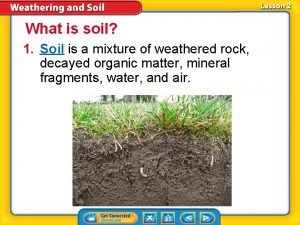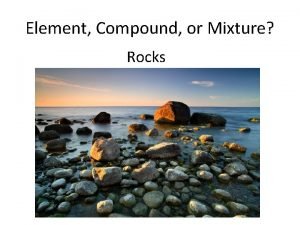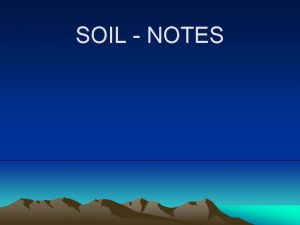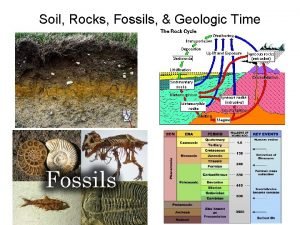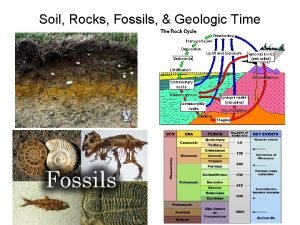NATURE OF SOIL SOIL Soil is a mixture









- Slides: 9

NATURE OF SOIL

SOIL Soil is a mixture of weathered rock, decayed organic matters, mineral fragments, water, and air. What is soil and where does it come from? 1. A layer of rock and mineral fragments produced by weathering covers the surface of Earth. 2. Weathering gradually breaks rocks into smaller and smaller fragments. 3. Plants and animals add organic matter, the remains of once-living organisms, to the rock fragments.

What Affects Soil Formation?

Composition of Soil The rock and mineral fragments found in soils come from rocks that have been weathered Most organic matter in soil comes from plants and decaying animals. The decayed organic matter turns into a dark-colored material called humus. Humus serves as a source of nutrients for plants. Soil has many small spaces between individual soil particles that are filled with water or air.

Soil Profile All the horizons of a soil form a soil profile. Horizons are the different layers of soil.

The A horizon is the top layer of soil. A. K. A topsoil Darkest layer might be covered with litter Litter consists of leaves, twigs, and other organic material that eventually can be changed to humus. The next layer is the B horizon. lighter in color and contains less humus. Leaching is the removal of minerals that have been dissolved in water-carries the material into the B horizon. The C horizon is the last layer. consists of partially weathered rock does not contain much organic matter and is not strongly affected by leaching.

Soil Types Reflect Climate Deserts contain little organic material and also are thinner than soils in wetter climates Prairie soils have thick, dark A horizons because the grasses that grow there contribute lots of organic matter Temperate forest soils have thinner A horizons and B horizons that have been enriched in many elements because of leaching Other regions such as tundra and tropical areas also have distinct soils.

Other Factors that Affect Soil Parent material has an effect on the soils that develop from it. Type of vegetation then affects soil formation. Time also affects soil development. If weathering has been occurring for only a short time, the parent rock determines the soil characteristics The slope of the land affects soil development

Soil Erosion Soil erodes when it is moved from the place where it formed. Erosion is more severe on steep slopes and where there is little vegetation. The amount of rain will also affect the amount of erosion
 Homogeneous mixture and heterogeneous mixture class 9
Homogeneous mixture and heterogeneous mixture class 9 Soil is a mixture of
Soil is a mixture of Is sand a pure substance
Is sand a pure substance Soil is a mixture of weathered rock and
Soil is a mixture of weathered rock and Soil layers
Soil layers Is rocks a compound element or mixture
Is rocks a compound element or mixture Nature and nature's law lay hid in night
Nature and nature's law lay hid in night Determinace lidské psychiky
Determinace lidské psychiky Living soil vs dead soil
Living soil vs dead soil Living soil vs dead soil
Living soil vs dead soil

